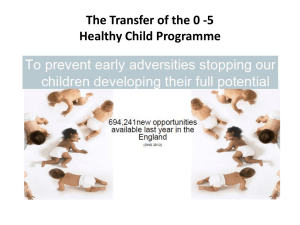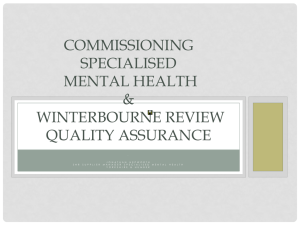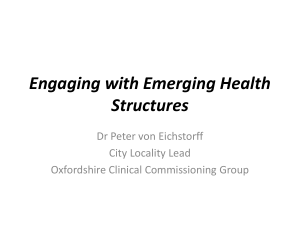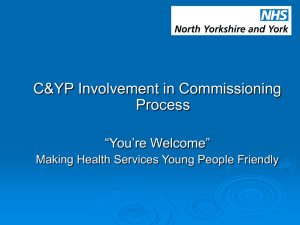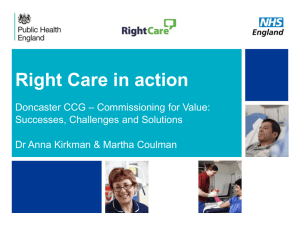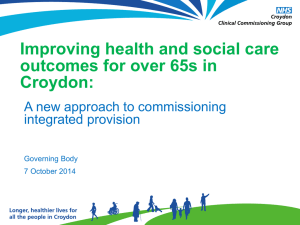GM Health System, Warren Heppolette
advertisement
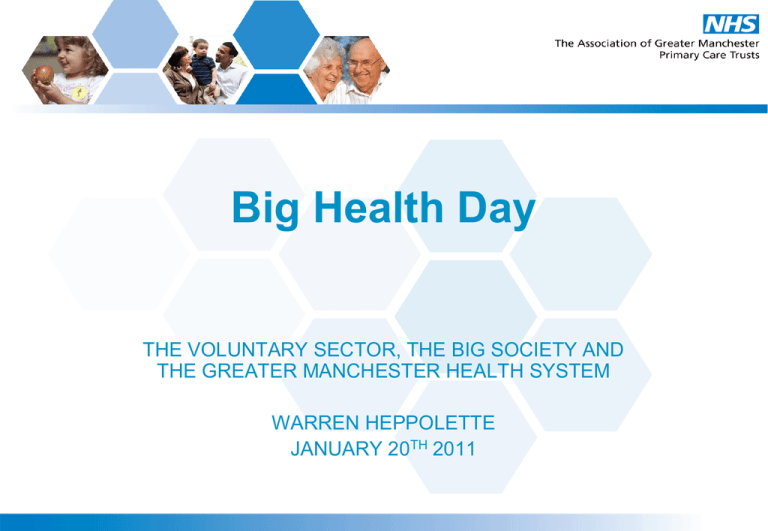
Big Health Day THE VOLUNTARY SECTOR, THE BIG SOCIETY AND THE GREATER MANCHESTER HEALTH SYSTEM WARREN HEPPOLETTE JANUARY 20TH 2011 Overview Context •The Greater Manchester NHS and the Voluntary & Community Sector A Challenging Present •QIPP, the efficiency challenge and deficit reduction •Liberating the NHS – the NHS White Paper A Positive Future •Population health and Greater Manchester’s Assets •A thriving social market for health Context The Greater Manchester NHS and the Voluntary & Community Sector A population of 2.8m people served by 10 PCTs, 10 Acute Trusts (8FTs), 10 Metropolitan Councils (now operating collectively as a Combined Authority). Bury Bolton 14.07 % Bolton WWL Greater Manchester is marked by significant cross boundary acute flows, which provides the rationale for much of the work which has defined collaboration in recent years ALW 4.60% 24.23 % 70.65 % PENNINE 6.17% 65.30 % HMR 77.66 % 58.26 % 6.12% 28.51 % 82.67 % Oldham 8.69% Salford 71.98 % M/cr Salford 12.94 % 23.87 % 8.54% Tameside 50.90 % 6.56% 8.35% Trafford 1st 12.91 % T&G 46.14 % 30.33 % CMFT 36.05 % 2nd 8.72% 3rd Trafford Provider 24.30 % Stockport 17.93 % 24.85 % 28.50 % UHSM 11.57 % Stockport 59.15 % PCT GM Elective Admissions 2009/10 Greater Manchester’s Voluntary Sector The voluntary sector of Greater Manchester is the largest outside London with over 11,000 organisations (6% of the national sector). • The sector directly employs 67,000 staff (5% of the workforce) • This does not include around 235,000 unpaid staff and trustees and over a million volunteers •It contributes at least £1.6 billion to the Greater Manchester economy (much more if the value of unpaid work is included). •There are over 5,000 registered charities History of Collaborative working Greater Manchester has the most developed system of cross-city collaboration in the UK outside London. This is most expressly illustrated through the recent agreement of Combined Authority status for the 10 Councils. This now provides for accountable political leadership operating at the Greater Manchester level. Since 2004 the 10 PCTs have pursued formal collaboration, underpinned by a governing Constitution, providing a means of collective decision making for health care commissioning. Since 1975 the GMCVO has existed to promote a thriving, effective and influential voluntary sector History of Collaborative working Since 2004 these arrangements have delivered: •A major reconfiguration of maternity and children’s services as part of Making it Better building on the biggest public consultation in the NHS’s history. •Reconfiguration of acute stroke services introducing three hyper acute centres providing service to the whole of the GM population, winning the HSJ Award last year for World Class Commissioning. •Development of a leading edge Public Health Network overseeing evidence based practice, joint screening programmes, marketing and communications and major prevention programmes on tobacco, alcohol, and healthy weight. •Establishment of the GM Health Commission representing a formal partnership between the 10 Councils and the NHS under the auspices of the Combined Authority •Development of the Health Partnership between the PCTs and the GMCVO and the emergence of the UK’s largest VCS procurement consortium GM Health Partnership Informing Commissioning •Support to Psychological Therapies Tender process •Voluntary sector health website and service directory Supporting Commissioning •Hepatitis C Tender •VCS Health & Wellbeing Consortium Building Partnerships •Health & Community Transport •Representing the sector in GM work Supporting Localities •Delivering Racial Equality in Mental Health •Synergy’ the open forum for local infrastructure staff with a specialism in health and social care A Challenging Present Trends in NHS Expenditure (Source:- King's Fund & IFS "How Cold Will It Be?") Budget commitment for real growth across public sector beyond 2010/11 Highest annual average by Government administration (1997 - 2011) Lowest annual average by Government administration (1951 - 63) 21st century average annual increase 20th century average annual increase Annual real spend increase since 1948 0 1 2 3 4 Percentage Real Growth in NHS Expenditure 5 6 7 QIPP – The Productivity & Efficiency Challenge The financial challenge facing the NHS is without precedent. This will be a hugely challenging scenario given the continued increases in demand for NHS services over a long period of time. This is a complex multi-factorial issue relating to supply, technological advance, fresh entitlements and the changing population demographics. It is difficult to conceive that this demand will reduce. Furthermore, there are a number of baseline inflationary pressures within the NHS system which, if unaddressed, may require further funding – pay (both pay awards and incremental points), non-pay and estate costs. It is estimated that the “stand-still” inflationary pressures could be of the order of 5% per annum, thus making flat cash, in effect, a real terms reduction in funding We estimate the size of the gap to be addressed across Greater Manchester is £1.4bn Financial Picture – Acute Funding Efficiency Prospectus NHS White Paper – Liberating the NHS •GP led commissioning •Information Revolution •HealthWatch •NHS Commissioning Board •Public Health Transfer •Health & Well-Being Boards •Place Based Budgeting 2010/11 Creating the New Commissioning Architecture 2011/12 2013+ Local GP Consortia 10 Local Authorities PCT Clustering 10 PCTs NW SHA •Maintain quality, safety, performance and financial balance •Oversight of QIPP Plans •Closedown of the PCTs •Handover to consortia •Commissioning & contracting for the NHSCB •Development of initial commissioning support arrangements 10 Health & Wellbeing Boards Various support arrangements GM Combined Authority GM H&WB Board Embedding Leadership for Public Health Healthy Lives Healthy People 10 PCTs •Transfer of function GM NHS Commissioning Board? •Ringfenced budgets •Public Health England Managing transition – containment & creativity Wind Down Ramp up The crisis consists precisely in the fact that the old is dying and the new cannot be born; in this interregnum a great variety of morbid symptoms appear A Positive Future Health & Well Being Boards •The space to reframe the health partnership between public services, the voluntary sector and communities. The contribution of the voluntary and community sector… Leadership, Voice & Advocacy Inform and shape commissioning strategy Design, deliver and support services Joint Strategic Needs Assessment – Big Society, Asset Based Approach •Tackling the deficiency model •Mapping the strengths and assets of our communities •Proving the effectiveness of the social market to inform longer term commissioning •Public Health Responsibility Deal A Thriving Social Market •Securing a social finance architecture •Recognising shifts in funding principles – Payment for Success •Bridging national policy with local ownership – eg tackling worklessness •Rethinking procurement – the opportunity of the Consortium •Meaningful engagement in Community Budgeting Community Budgets • Aligns directly with GMS approach • Continued GM influence on government policy • Potential to develop our four themes: 0-5 Worklessness Offender Management Child Poverty And other social challenges that need more joining up Community Budget Real joint investment: ‘Table stakes’ Secured commitment to pool/flex local resources Spare seats DWP Jobcentre Plus GM PROBATIO N GM POLICE e.g. Premises Discretiona ry Funds e.g. Local commissio ning budgets e.g. Neighbour hood Policing e.g. Social Impact Bonds Other public services Private Sector Social Impact Bond Investors ‘Asks’ of Whitehall Depts Re: flexibilities, barriers, incentives, targets Trusts Lottery Etc.. e.g. Local commissio ning budgets e.g. Public health GP budgets DWP Prime contractor( s) Health Range of LA place based resources AGMA/ Combined Authority CVS? DWP Jobcentre Plus Spare seats GM PROBATIO N Proposed Interventions ‘Business case’ Evaluation: outcomes/cost benefits ‘Dividend’ distribution (Whitehall, Agency, Community, replenish fund) Roll out decisions Mainstreaming De commissioning Intervention delivery Investor alignment Integrated Commissioning Model DWP Prime contractor( s) Health GM POLICE ‘Gateway’ assessment Plausibility Capacity Returns on investment (to who, how, when) Align investor resources Mainstreaming plan AGMA/ Combined Authority CVS? Concluding messages for the sector • Your knowledge, connections and ‘reach’ are an asset • You need to be able to quantify, describe and sell those benefits • There may be opportunities to make some early running during the significant transition

